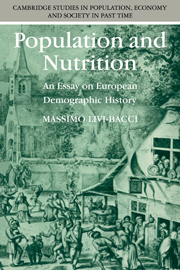Book contents
- Frontmatter
- Contents
- List of figures
- List of tables
- Preface
- 1 Demographic growth in Europe
- 2 Energy, nutrition and survival
- 3 Famine and want
- 4 The starving and the well-fed
- 5 Food and standard of living: hypotheses and controversies
- 6 Antagonism and adaptation
- Notes
- General index
- Cambridge Studies in Population, Economy and Society in Past Time
3 - Famine and want
Published online by Cambridge University Press: 20 October 2009
- Frontmatter
- Contents
- List of figures
- List of tables
- Preface
- 1 Demographic growth in Europe
- 2 Energy, nutrition and survival
- 3 Famine and want
- 4 The starving and the well-fed
- 5 Food and standard of living: hypotheses and controversies
- 6 Antagonism and adaptation
- Notes
- General index
- Cambridge Studies in Population, Economy and Society in Past Time
Summary
Starvation and survival: clinical and historical cases
What happens to the human organism when its intake of food is reduced, it crosses the critical threshold of malnutrition and stays below it for a shorter or longer, but transitory, amount of time? Passing from individual or clinical case histories to the experiences of entire communities, what happens to a population that through want, war or some other catastrophe has to survive for a lengthy period with food availability clearly below what is considered adequate?
The lessons that can be learned from clinical and historical cases about the relationship between short-term nutritional stress and survival will be the object of this chapter. The assumption is that by studying cases that are extreme but neither abnormal nor infrequent in the past, we may gain a better insight into the mechanisms of resistance and adaptability in the face of food shortage.
The human body has developed a degree of adaptability to a lack of food. A fast lasting the biblical forty days and forty nights is well within reach of any healthy adult and should not entail, providing the subsequent return to an adequate diet, any long-term adverse effects. Many interpret this resistance as the consequence of a long selection process taking place over hundreds of thousands of years during which man, or his precursors, lived by hunting and gathering in unstable environments, subject to recurring periods of scarcity.
- Type
- Chapter
- Information
- Population and NutritionAn Essay on European Demographic History, pp. 40 - 62Publisher: Cambridge University PressPrint publication year: 1991



